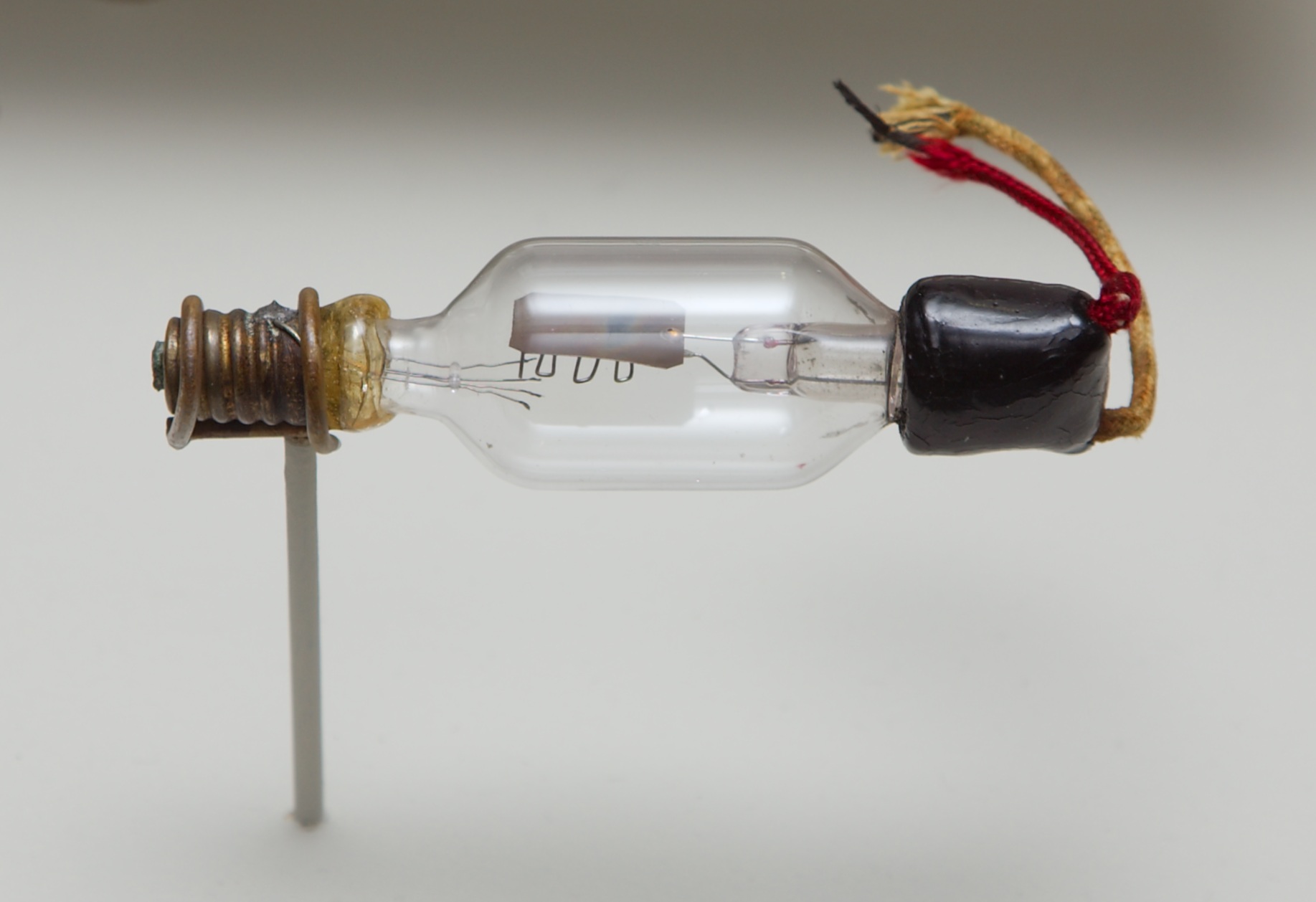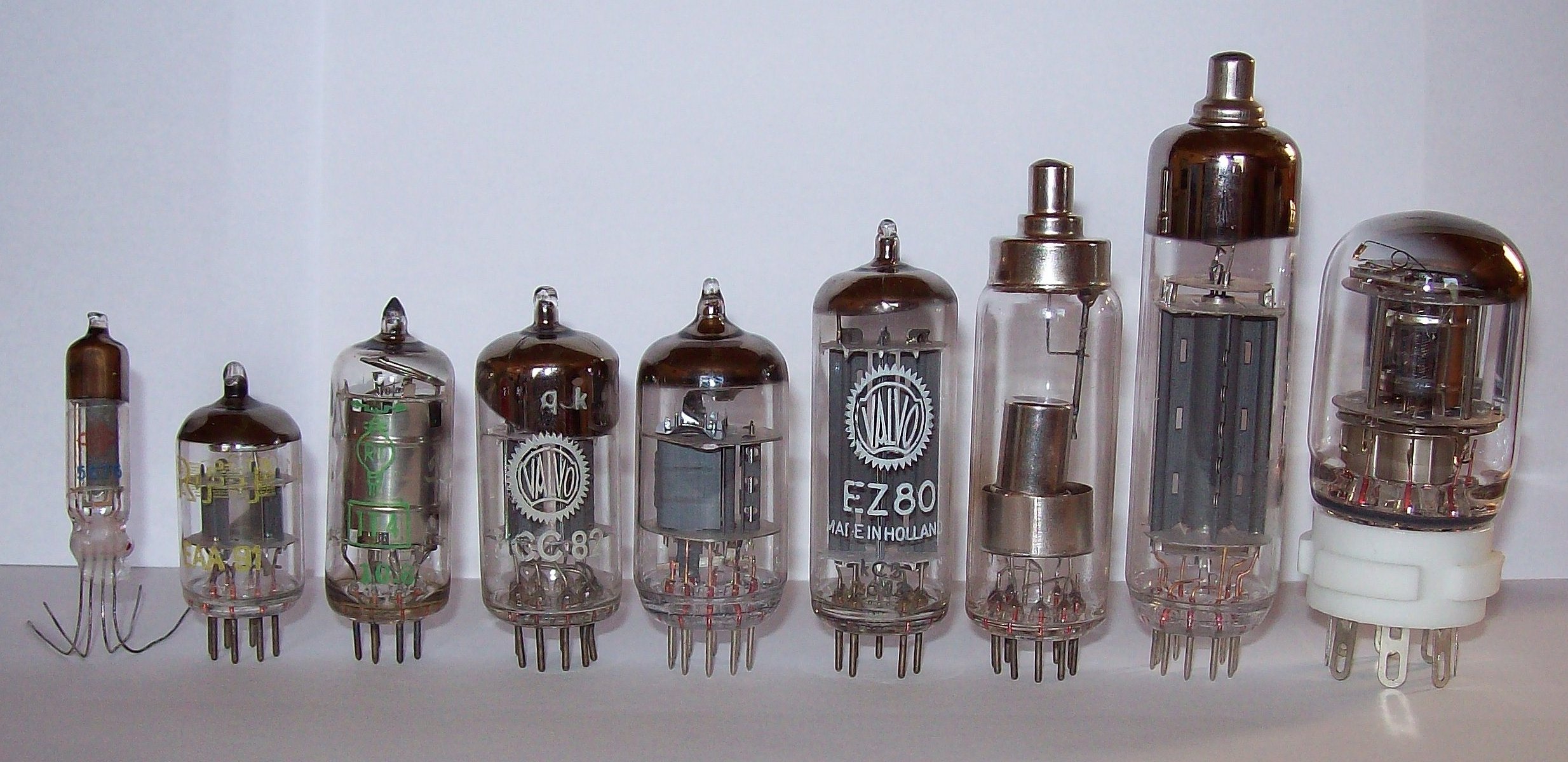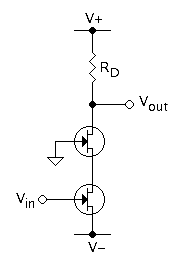|
6N24P
The 6N24P (Russian: 6Н24П) is a miniature Russian-made medium gain dual, frame grid triode vacuum tube, intended for service as a cascode amplifier at HF through VHF frequencies. The construction of the tube is asymmetrical, with the control grid of the first triode section (pin no. 2) being internally connected to the internal RF shielding plate, thereby making the first section more suitable for common grid operation. It is a direct equivalent of ECC89 and 6FC7 vacuum tubes. Basic data Uf = 6.3V, If = 300 mA uM = 33 Ia = 15 mA S = 12.5 mA/V Pa = 1.8 W See also *6N14P The 6N14P (Russian: 6Н14П) is a miniature Russian-made medium gain dual triode vacuum tube, intended for service as a low- noise cascode amplifier at HF through VHF Very high frequency (VHF) is the ITU designation for the range of radio ... * 6DJ8 External links 6N24P tube datasheet [...More Info...] [...Related Items...] OR: [Wikipedia] [Google] [Baidu] |
6N14P
The 6N14P (Russian: 6Н14П) is a miniature Russian-made medium gain dual triode vacuum tube, intended for service as a low- noise cascode amplifier at HF through VHF Very high frequency (VHF) is the ITU designation for the range of radio frequency electromagnetic waves (radio waves) from 30 to 300 megahertz (MHz), with corresponding wavelengths of ten meters to one meter. Frequencies immediately below VHF ... frequencies. It is a direct equivalent of ECC84 and 6CW7 vacuum tubes. Basic data Uf = 6.3V, If = 350 mA uM = 25 Ia = 10.5 mA S = 6.8 mA/V Pa = 1.5 W History of Use In the Soviet Union 6N14P found application in special equipment and to a lesser extent in more-expensive FM receivers and television sets in the 1960s. However, in the majority of medium and low-grade Soviet-produced FM radios a more general purpose 6N3P (2C51) vacuum tube was utilized, as the lower frequency OIRT FM band used in the USSR (65.8 to 74 MHz) allowed for less stringent nois ... [...More Info...] [...Related Items...] OR: [Wikipedia] [Google] [Baidu] |
6N24P Vacuum Tube
6N or 6-N may refer to: *6N or 6°N, the 6th parallel north latitude * Nordic Airways, IATA airline designator * List of highways numbered 6N **U.S. Route 6N ** U.S. Route 6 in New York **US 6N (NY), see U.S. Route 209 in New York * Six Nations Championship, the annual northern hemisphere rugby union competition sometimes abbreviated as 6N *ER-6n, a model of Kawasaki Ninja 650R *Extrom 6N, see Caprolactam *Typ 6N, internal corporate name for Volkswagen Polo Mk3 *6N caves, see List of caves in Western Australia *6N, the production code for the 1984 ''Doctor Who'' serial ''Frontios ''Frontios'' is the third serial of the 21st season of the British science fiction television series '' Doctor Who'', which was first broadcast in four twice-weekly parts on BBC1 from 26 January to 3 February 1984. Set in the far future, the ser ...'' See also * N6 (other) {{Letter-NumberCombDisambig ... [...More Info...] [...Related Items...] OR: [Wikipedia] [Google] [Baidu] |
Russia
Russia (, , ), or the Russian Federation, is a transcontinental country spanning Eastern Europe and Northern Asia. It is the largest country in the world, with its internationally recognised territory covering , and encompassing one-eighth of Earth's inhabitable landmass. Russia extends across eleven time zones and shares land boundaries with fourteen countries, more than any other country but China. It is the world's ninth-most populous country and Europe's most populous country, with a population of 146 million people. The country's capital and largest city is Moscow, the largest city entirely within Europe. Saint Petersburg is Russia's cultural centre and second-largest city. Other major urban areas include Novosibirsk, Yekaterinburg, Nizhny Novgorod, and Kazan. The East Slavs emerged as a recognisable group in Europe between the 3rd and 8th centuries CE. Kievan Rus' arose as a state in the 9th century, and in 988, it adopted Orthodox Christianity from the ... [...More Info...] [...Related Items...] OR: [Wikipedia] [Google] [Baidu] |
Triode
A triode is an electronic amplifying vacuum tube (or ''valve'' in British English) consisting of three electrodes inside an evacuated glass envelope: a heated filament or cathode, a grid, and a plate (anode). Developed from Lee De Forest's 1906 Audion, a partial vacuum tube that added a grid electrode to the thermionic diode ( Fleming valve), the triode was the first practical electronic amplifier and the ancestor of other types of vacuum tubes such as the tetrode and pentode. Its invention founded the electronics age, making possible amplified radio technology and long-distance telephony. Triodes were widely used in consumer electronics devices such as radios and televisions until the 1970s, when transistors replaced them. Today, their main remaining use is in high-power RF amplifiers in radio transmitters and industrial RF heating devices. In recent years there has been a resurgence in demand for low power triodes due to renewed interest in tube-type audio systems by ... [...More Info...] [...Related Items...] OR: [Wikipedia] [Google] [Baidu] |
Vacuum Tube
A vacuum tube, electron tube, valve (British usage), or tube (North America), is a device that controls electric current flow in a high vacuum between electrodes to which an electric voltage, potential difference has been applied. The type known as a thermionic tube or thermionic valve utilizes thermionic emission of electrons from a hot cathode for fundamental electronic functions such as signal amplifier, amplification and current rectifier, rectification. Non-thermionic types such as a vacuum phototube, however, achieve electron emission through the photoelectric effect, and are used for such purposes as the detection of light intensities. In both types, the electrons are accelerated from the cathode to the anode by the electric field in the tube. The simplest vacuum tube, the diode (i.e. Fleming valve), invented in 1904 by John Ambrose Fleming, contains only a heated electron-emitting cathode and an anode. Electrons can only flow in one direction through the device—fro ... [...More Info...] [...Related Items...] OR: [Wikipedia] [Google] [Baidu] |
Cascode
The cascode is a two-stage amplifier that consists of a common-emitter stage feeding into a common-base stage. Compared to a single amplifier stage, this combination may have one or more of the following characteristics: higher input–output isolation, higher input impedance, high output impedance, higher bandwidth. In modern circuits, the cascode is often constructed from two transistors ( BJTs or FETs), with one operating as a common emitter or common source and the other as a common base or common gate. The cascode improves input–output isolation (reduces reverse transmission), as there is no direct coupling from the output to input. This eliminates the Miller effect and thus contributes to a much higher bandwidth. History The use of a cascode (sometimes verbified to ''cascoding'') is a common technique for improving analog circuit performance, applicable to both vacuum tubes and transistors. The name "cascode" was coined in an article written by Frederick Vinton ... [...More Info...] [...Related Items...] OR: [Wikipedia] [Google] [Baidu] |
Amplifier
An amplifier, electronic amplifier or (informally) amp is an electronic device that can increase the magnitude of a signal (a time-varying voltage or current). It may increase the power significantly, or its main effect may be to boost the voltage or current ( power, voltage or current amplifier). It is a two-port electronic circuit that uses electric power from a power supply to increase the amplitude of a signal applied to its input terminals, producing a greater amplitude signal at its output. The ratio of output to input voltage, current, or power is termed gain (voltage, current, or power gain). An amplifier, by definition has gain greater than unity (if the gain is less than unity, the device is an attenuator). An amplifier can either be a separate piece of equipment or an electrical circuit contained within another device. Amplification is fundamental to modern electronics, and amplifiers are widely used in almost all electronic equipment. Amplifiers can be cat ... [...More Info...] [...Related Items...] OR: [Wikipedia] [Google] [Baidu] |
High Frequency
High frequency (HF) is the International Telecommunication Union, ITU designation for the range of radio frequency electromagnetic waves (radio waves) between 3 and 30 megahertz (MHz). It is also known as the decameter band or decameter wave as its wavelengths range from one to ten decametre, decameters (ten to one hundred meters). Frequencies immediately below HF are denoted medium frequency (MF), while the next band of higher frequencies is known as the very high frequency (VHF) band. The HF band is a major part of the shortwave band of frequencies, so communication at these frequencies is often called shortwave radio. Because radio waves in this band can be reflected back to Earth by the ionosphere layer in the atmosphere – a method known as "skip" or "skywave" propagation – these frequencies are suitable for long-distance communication across intercontinental distances and for mountainous terrains which prevent Line-of-sight propagation, line-of-sight communica ... [...More Info...] [...Related Items...] OR: [Wikipedia] [Google] [Baidu] |
Control Grid
The control grid is an electrode used in amplifying thermionic valves (vacuum tubes) such as the triode, tetrode and pentode, used to control the flow of electrons from the cathode to the anode (plate) electrode. The control grid usually consists of a cylindrical screen or helix of fine wire surrounding the cathode, and is surrounded in turn by the anode. The control grid was invented by Lee De Forest, who in 1906 added a grid to the Fleming valve ( thermionic diode) to create the first amplifying vacuum tube, the Audion ( triode). Operation In a valve, the hot cathode emits negatively charged electrons, which are attracted to and captured by the anode, which is given a positive voltage by a power supply. The control grid between the cathode and anode functions as a "gate" to control the current of electrons reaching the anode. A more negative voltage on the grid will repel the electrons back toward the cathode so fewer get through to the anode. A less negative, o ... [...More Info...] [...Related Items...] OR: [Wikipedia] [Google] [Baidu] |
Common Gate
In electronics, a common-gate amplifier is one of three basic single-stage field-effect transistor (FET) amplifier topologies, typically used as a current buffer or voltage amplifier. In this circuit, the source terminal of the transistor serves as the input, the drain is the output, and the gate is connected to ground, or "common," hence its name. The analogous bipolar junction transistor circuit is the common-base amplifier. Applications This configuration is used less often than the common source or source follower. It is useful in, for example, CMOS RF receivers, especially when operating near the frequency limitations of the FETs; it is desirable because of the ease of impedance matching and potentially has lower noise. Gray and Meyer provide a general reference for this circuit. Low-frequency characteristics At low frequencies and under small-signal conditions, the circuit in Figure 1 can be represented by that in Figure 2, where the hybrid-pi model for the MOSFET ... [...More Info...] [...Related Items...] OR: [Wikipedia] [Google] [Baidu] |
6DJ8
The 6DJ8 is a miniature nine-pin medium gain dual triode vacuum tube. It is distinguished by its very high transconductance, mostly the result of its frame grid construction. Versions of the tube are named ECC88, E88CC, 6922, E188CC, CV4108, 7308, 6N1P and 6N23P. Origins The tube was developed by Philips in the Netherlands under European designation ECC88. The series-string version 7DJ8 / PCC88 was also introduced at the same time. The 6DJ8 was designed for use as a low-noise amplifier in VHF and UHF TV tuners, an improved successor to the usual 6BK7, but due to its high gain it was heavily used in high-end test equipment, for example, most high-quality oscilloscopes from the 1950s to the 1960s utilize a number of 6DJ8 tubes. Audio Although not originally designed for the purpose, it became popular in hi-fi audio amplifiers. European-produced version of the tube is designated ECC88. An industrial (improved/higher ratings) version of the tube was designated 6922 / E88CC betw ... [...More Info...] [...Related Items...] OR: [Wikipedia] [Google] [Baidu] |





